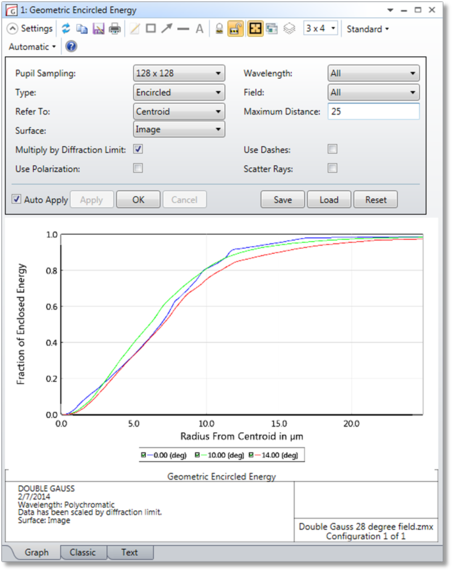Geometric
Computes encircled energy using ray-image surface intercepts.

Sampling The size of the ray grid used to sample the pupil. The sampling may be 32x32, 64x64, etc. Although higher sampling yields more accurate data, calculation times increase.
Type The analysis type option specifies how the encircled energy is calculated; either encircled (radial), X-only, Y-only, or ensquared.
Max Distance This setting overrides the default scaling. The units are micrometers. To choose the default scaling option, enter zero.
Use Dashes Selects either solid lines or dashed lines to differentiate the various curves.
Refer To Select either chief ray, centroid, vertex, or middle as the reference point. The middle is the coordinate upon which the smallest circle enclosing all the ray intercepts is centered.
Surface Selects the surface at which the data is to be evaluated. This is useful for evaluating intermediate images. See "Evaluating results at intermediate surfaces".
Wavelength The wavelength number to be used in the calculation.
Field The field number for which the calculation should be performed.
Multiply by Diffraction Limit If checked, OpticStudio approximates the diffraction encircled energy by scaling the geometric data by the theoretical diffraction limit curve computed for a rotationally symmetric Airy disk. The only way to compute an obscured or asymmetric pupil diffraction limit function would be to perform an exact diffraction calculation, in which case the diffraction encircled energy feature should be used instead. The diffraction limit approximation is only useful for systems with unobscured pupils, reasonably rotationally symmetric images, and modest field angles since the approximation ignores the change in F/# with field.
Use Polarization If checked, polarization is considered. See " Polarization (system explorer) " for information on defining the polarization state and how polarization is used by analysis features.
Scatter Rays If checked, rays will be statistically scattered at ray-surface intercepts that have defined scattering properties. See " Surface scattering settings ".
Discussion The X- and Y-only options will compute the fraction of rays which are contained with plus or minus the specified distance from either the chief ray or the image centroid. If a scale of 10 micrometers is shown, then the region enclosed is 20 micrometers across (and infinite in the other direction). The geometric encircled energy is not a good indicator of performance if the system is close to diffraction limited.
Next:


